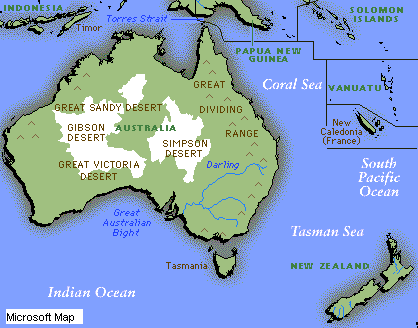Later during Paleocene
During the Paleocene, Gondwana continued to break up, and New Zealand was moving
northward and thus to a more temperate climate. The Tasman Sea continued its
growth, breaking the "shallow marine links" between Australia and New Zealand.
This ended about 60 million years ago when the Tasman reached it's finale width
of 1850km.
Around 55 million years ago, ocean floor spreading began to occur between Australia
and Antarctica, further pushing New Zealand to the north until the Eocene when
it's latitude was 45-40žS compared to 50-45žS in the Paleocene.
In the late Eocene, New Zealand and New Caledonia were separated due to the
opening of the South Fiji Basin. Previously, they had never been separated and had
evolved simultaneously.
 Although the fauna and flora of New Caledonia and New Zealand are very similar,
there are some very distinct and very interesting differences. Both of these
countries are devoid of mammals (except for the bat)and snakes. They also both have a large
array of flightless birds as well as similar forests. On the other hand,
New Caledonia lacks indigenous amphibians, freshwater fish, and freshwater mussels
(even as fossils), New Zealand's primitive frog, and the tuatara. There is a vast
collection, however, of very primitive and very particular plants in New Caledonia.
Although the fauna and flora of New Caledonia and New Zealand are very similar,
there are some very distinct and very interesting differences. Both of these
countries are devoid of mammals (except for the bat)and snakes. They also both have a large
array of flightless birds as well as similar forests. On the other hand,
New Caledonia lacks indigenous amphibians, freshwater fish, and freshwater mussels
(even as fossils), New Zealand's primitive frog, and the tuatara. There is a vast
collection, however, of very primitive and very particular plants in New Caledonia.
BACK
HOME
FORWARD
 Although the fauna and flora of New Caledonia and New Zealand are very similar,
there are some very distinct and very interesting differences. Both of these
countries are devoid of mammals (except for the bat)and snakes. They also both have a large
array of flightless birds as well as similar forests. On the other hand,
New Caledonia lacks indigenous amphibians, freshwater fish, and freshwater mussels
(even as fossils), New Zealand's primitive frog, and the tuatara. There is a vast
collection, however, of very primitive and very particular plants in New Caledonia.
Although the fauna and flora of New Caledonia and New Zealand are very similar,
there are some very distinct and very interesting differences. Both of these
countries are devoid of mammals (except for the bat)and snakes. They also both have a large
array of flightless birds as well as similar forests. On the other hand,
New Caledonia lacks indigenous amphibians, freshwater fish, and freshwater mussels
(even as fossils), New Zealand's primitive frog, and the tuatara. There is a vast
collection, however, of very primitive and very particular plants in New Caledonia.